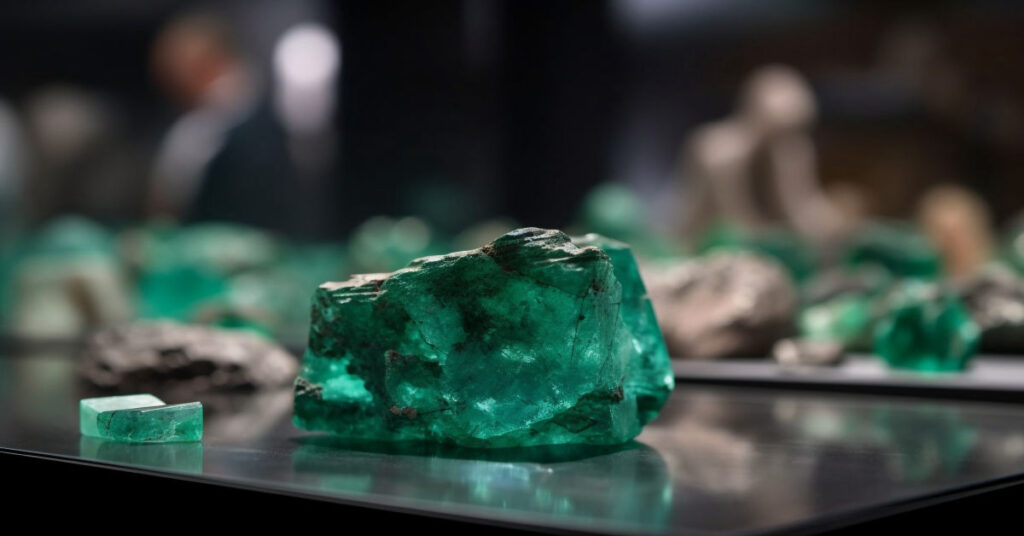For centuries, a vibrant green stone has been revered by emperors, coveted by collectors, and cherished across cultures. While often simply called “jade,” the term encompasses two distinct minerals: nephrite and the far rarer, and often more valuable, jadeite (known in Slovak as jadeitový kameň). This article delves into the world of jadeite, exploring its unique properties, historical significance, and what makes it one of the most precious gemstones on Earth.
What Exactly is Jadeite?
Jadeite is a sodium and aluminium-rich pyroxene mineral. Its formation requires exceptionally specific geological conditions of low temperature and very high pressure, typically found in subduction zones where tectonic plates collide. This rare genesis makes fine-quality jadeite significantly less common than diamond.
Unlike nephrite, which is known for its toughness and creamy, fibrous appearance, jadeite is prized for its brilliance, translucency, and a much wider and more vivid color palette. Its microcrystalline structure can be so fine that it allows for a brilliant, glassy luster when polished.
A Spectrum of Imperial Colors
When most people imagine jadeite, they picture a rich, emerald-green hue. This specific color, known as “Imperial Jade,” is the most celebrated and valuable.
However, jadeite’s beauty extends far beyond green.
- Lavender: jadeitový kameň A popular and valuable color, caused by manganese.
- Red and Yellow: jadeitový kameň Caused by iron oxide staining along fractures.
- White or Transparent: jadeitový kameň Pure jadeite is white; some varieties can be nearly transparent.
- Black: (Often referred to as “black jade,” which can be either jadeite or nephrite).
- Blue: A rare and sought-after shade, sometimes called “ocean jade.”
Cultural and Historical Significance
- Mesoamerica: The Olmec, Maya, and Aztec civilizations held jadeite in higher esteem than gold. It was carved into ritual objects, masks, and ceremonial items, symbolizing life, water, and fertility.
- China: While nephrite was used for millennia, jadeite, known as feicui, was introduced from Burma (Myanmar) in the 18th century and quickly became the favorite of the Qing Dynasty emperors and aristocracy. It became synonymous with status, purity, and protection. The phrase, “Gold has a value; jade is invaluable,” underscores its cultural importance.
The “Holy Grail”: Myanmar’s Mines
The primary source of the world’s finest jadeite is northern Myanmar (Burma), specifically the region around Kachin State. For over two centuries, the mines of Hpakant have produced nearly all of the top-quality “Imperial” green jadeite. Other sources include Guatemala, Japan, Kazakhstan, and the USA, but their output rarely matches the quality and intensity of color found in Burmese jadeite.
Value and Evaluation: The 3 Ts and C
The value of jadeite is judged by a system often called the “3 Ts and C”:
- Color: The most important factor. The ideal is a intense, vibrant, and even green (“Imperial Green”) that is neither too dark nor too light.
- Translucency: High-quality jadeite appears to glow from within. The finest pieces are semi-transparent to transparent.
- Texture: The best jadeite has an extremely fine, smooth, and uniform grain structure with no visible crystals.
- Cutting/Craftsmanship: The skill of the carver can dramatically enhance the stone’s color and translucency. A masterful carving adds significant artistic and monetary value.
Treatment is a critical factor. Untreated, natural jadeite (known as Type A) is the most valuable. These treatments are common but significantly reduce the stone’s value and stability.
Today, jadeite remains a symbol of luxury and cultural heritage. At major international auctions, top-quality pieces of Imperial Jadeite continue to break records, securing its place as one of the most alluring and mysterious gemstones in human history.
FAQs
Q1: What is the difference between jadeite and nephrite?
A: While both are called “jade,” they are different minerals.
- Jadeite is harder, denser, and can achieve a brilliant, glassy luster. It comes in more vibrant colors, including the famous Imperial Green.
- Nephrite is slightly softer but incredibly tough. Historically, Chinese carvings before the 18th century are primarily nephrite.
Q2: Why is some jadeite so incredibly expensive?
A: The price is driven by extreme rarity, cultural demand (especially in China), and quality. A fine, untreated piece of Imperial Green jadeite with excellent translucency is one of the rarest gemological finds. Its value per carat can easily surpass that of high-quality diamonds.
Q3: How can I tell if my jadeite is real or treated?
A: It is very difficult for an untrained eye. Treatments like polymer impregnation (Type B) and dyeing (Type C) can be detected through specialized gemological tests:
- Visual Clues: Treated jadeite may have a muted, “plastic-like” luster or unnatural, streaky color.
- Lab Testing: The only definitive way to confirm treatment is through testing at a reputable gemological laboratory (e.g., GIA, GUBELIN). They use spectroscopy and microscopy to identify polymers and dyes.
Q4: How should I care for my jadeite jewelry?
A: Jadeite is durable but can be chipped by a hard blow. To care for it:
- Clean it with warm, soapy water and a soft brush.
- Store it separately to avoid scratches from other jewelry.

